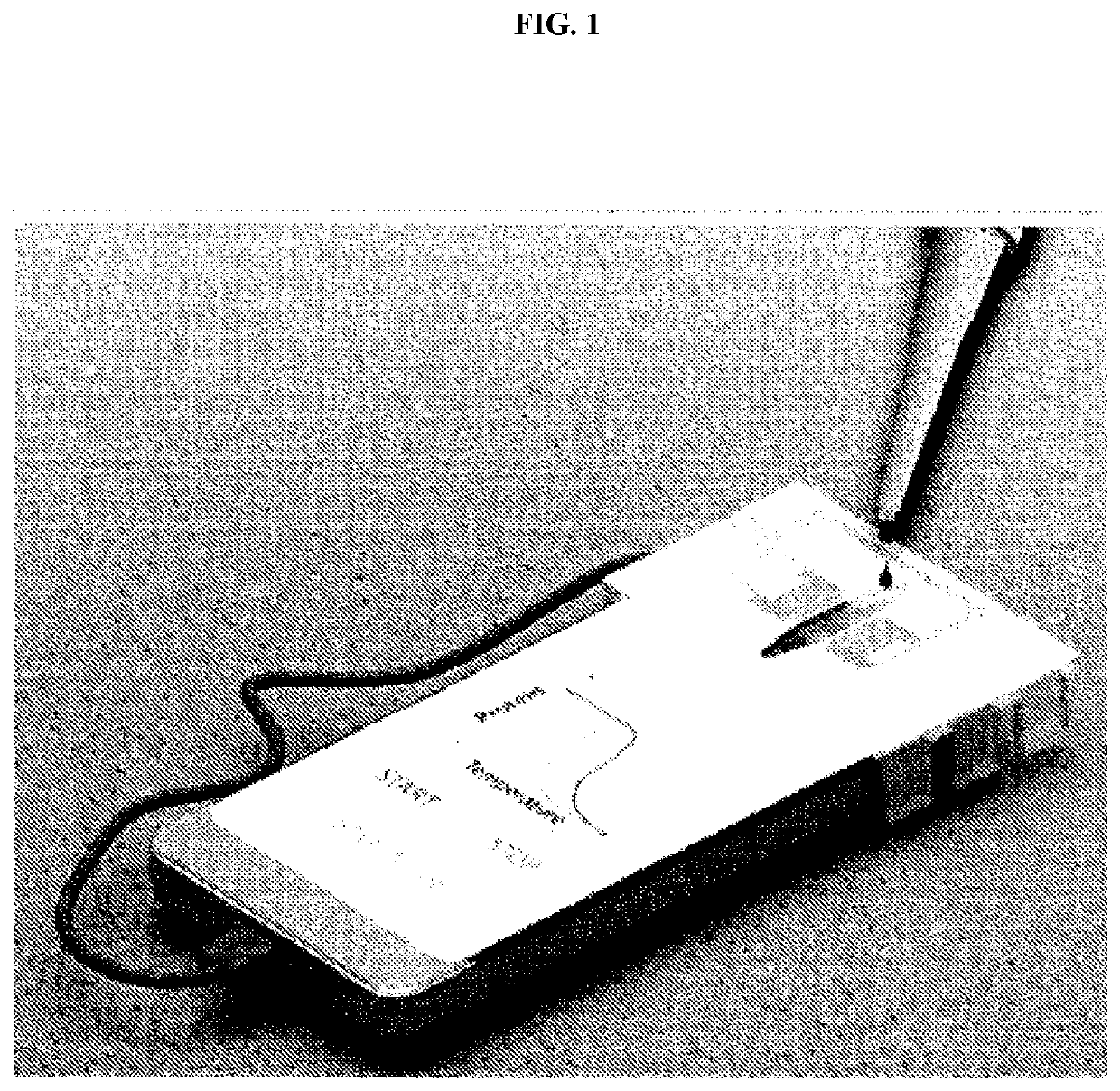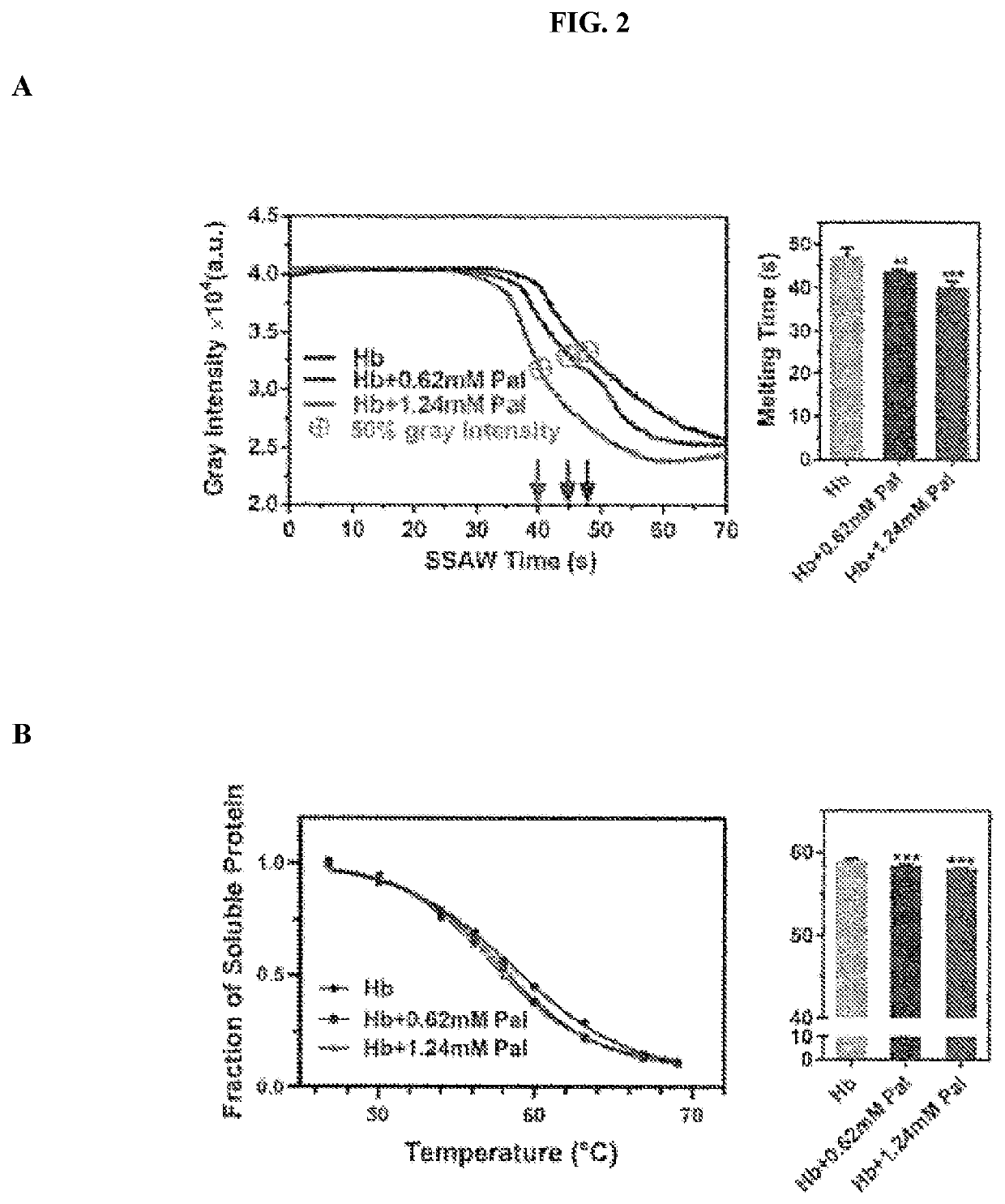Acousto-thermal shift assay for label-free protein analysis
- Summary
- Abstract
- Description
- Claims
- Application Information
AI Technical Summary
Benefits of technology
Problems solved by technology
Method used
Image
Examples
example i
Chemicals
[0103]Two proteins, i.e. human hemoglobin (Hb; Millipore Sigma, St. Louis, Mo., USA) and citrate synthase (CS) from porcine heart (Millipore Sigma), and two corresponding compounds, i.e. palmatine chloride (Pal; Santa Cruz Biotechnology, Santa Cruz, Calif., USA) and oxaloacetic acid (OAA; Millipore Sigma) were primarily used. Human whole blood samples with K2EDTA as an anticoagulant were purchased from Zen-Bio Inc. (Research Triangle Park, N.C., USA) and stored in 4° C. (always used within 3-14 days after collection). Human blood plasma was obtained by centrifuging the human whole blood samples at 500 g for 10 min in 4° C. Sickle cell diseased (SCD) red blood cell lysate were obtained from patients with SCD, upon receiving written informed consent and in conformity with the declaration of Helsinki under a protocol approved by the Duke University Medical Center (no. NCT02731157) as described previously. Culp-Hill et al., “Effects of red blood cell (RBC) transfusion on sickle...
example ii
A-TSA Device Fabrication
[0104]The SAW was generated and propagated on piezoelectric 128° Y-cut X-propagating lithium niobate (LiNbO3) wafer (500 μm thick). The device consisted of a pair of interdigitated transducers (IDTs) in parallel in order to generate two series of identical SAWs propagating in the opposite direction, producing a standing SAW. Each IDT consists of 30 pairs of electrodes (Cr / Au, 5 / 100 nm) with the width of electrode finger of 50 μm, pitch of 100 μm, and an aperture of 10 mm, yielding a frequency of approximately 20 MHz for the propagating SAW. Although different IDTs can be used, the resonance frequencies of most IDTs are in the range between 19.5 and 19.6 MHz. A PDMS microchannel with height of 100 μm and width of 2 mm was then fabricated through a standard soft-lithography and model-replica procedure. Lastly, both the PDMS channel and the IDT substrate were treated with oxygen plasma and bonded together to form the final SAW device. See, FIG. 4B.
example iii
Acousto-Thermal Shift Assay (A-TSA) and Data Analysis
[0105]The A-TSA SAW device was mounted on the stage of an inverted microscope (ECLIPSE Ti-U, Nikon, Japan). A radio frequency (RF) signal was generated by a function generator (EXG Analog Signal Generator, Keysight, Santa Rosa, Calif., USA) and amplified by an amplifier (403LA, Electronics & Innovation, Rochester, N.Y., USA). Five microliters of protein, plasma, red blood cell lysate or protein-compound mix solutions were injected into the channel before the RF signals were applied. A fast camera (ORCA-Flash4.0LT, Hamamatsu, Japan) was connected to the microscope to capture the process, and all the videos were recorded in 4 frames per second.
[0106]All image and videos processing were performed in ImageJ (National Institute of Health, Bethesda, Md., USA) in the same way as described below. The same sized regions of interest (ROIs) were traced around the perimeter of each pattered protein fiber in order to monitor the gray intensity...
PUM
 Login to View More
Login to View More Abstract
Description
Claims
Application Information
 Login to View More
Login to View More - R&D
- Intellectual Property
- Life Sciences
- Materials
- Tech Scout
- Unparalleled Data Quality
- Higher Quality Content
- 60% Fewer Hallucinations
Browse by: Latest US Patents, China's latest patents, Technical Efficacy Thesaurus, Application Domain, Technology Topic, Popular Technical Reports.
© 2025 PatSnap. All rights reserved.Legal|Privacy policy|Modern Slavery Act Transparency Statement|Sitemap|About US| Contact US: help@patsnap.com



